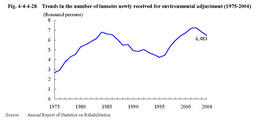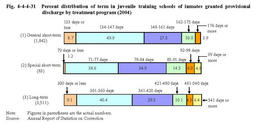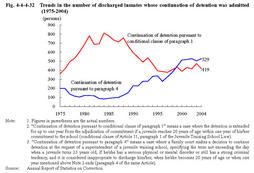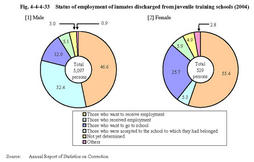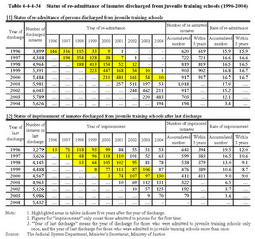| Previous Next Index Image Index Year Selection | |
|
|
6 Conditions of inmates who are discharged (1) Environmental adjustment During the period when a juvenile is in a juvenile training school,a probation officer and a volunteer probation officer in a probation office try to adjust his/her place of return suitable for rehabilitation,consulting with a guarantor on his/her future guidance and career plans,and communicating with him/her through letters or visits.
Fig.4-4-4-28 shows the number of inmates newly received for environmental adjustment over the last30years. Fig.4-4-4-28 Trends in the number of inmates newly received for environmental adjustment(1975-2004) (2) Parole Parole is granted by the Regional Parole Boards for inmates who have reached the highest grade(first grade-upper),when acknowledged proper for their rehabilitation,or for inmates who have not reached the highest grade but showed improvement in grades through efforts,when acknowledged especially necessary for their rehabilitation.
Fig.4-4-4-29 shows the number of inmates granted parole since1949. Fig.4-4-4-29 Trends in the number of inmates granted parole(1949-2004) (3) Reasons for discharge Table4-4-4-30 shows the number of discharged inmates in2004by reason.
About97%were granted provisional discharge with probationary supervision and about3%were granted discharge without probationary supervision.For most discharged inmates,transition from institutional treatment to community-based treatment is smoothly implemented. Table4-4-4-30 Number of discharged inmates by reason(2004) (4) Term in juvenile training schools Fig.4-4-4-31 shows the percent distribution of terms in juvenile training schools of inmates granted provisional discharge in2004by treatment program.
The average term in juvenile training schools was149days for general short-term treatment programs,83days for special short-term treatment programs,and384days for long-term treatment programs(Source:Annual Report of Statistics on Correction). Fig.4-4-4-31 Percent distribution of term in juvenile training schools of inmates granted provisional discharge by treatment program(2004) Fig.4-4-4-32 shows the number of discharged inmates for whom continuation of detention was admitted(pursuant to conditional clause of Article11,paragraph1and Article11,paragraph4of the Juvenile Training School Law)while they were in juvenile training schools since1975.Fig.4-4-4-32 Trends in the number of discharged inmates whose continuation of detention was admitted(1975-2004) (5) Status of employment Fig.4-4-4-33 shows the status of employment of discharged inmates in2004.
The percentage of discharged inmates who received employment was32.4%for males and5.3%for females.In1995,10years ago,the percentage was50.6%for males and10.2%for females.This shows that employment has become even more difficult for discharged inmates in recent years. Fig.4-4-4-33 Status of employment of inmates discharged from juvenile training schools(2004) (6) Status of re-admittance,etc. Table4-4-4-34 shows the status of re-admittance of discharged inmates between1996and2004.
The percentage of those re-admitted to juvenile training schools within five years from discharge was about16%,and the percentage of those admitted to prisons(only those admitted for the first time)within five years from discharge(the last discharge in the case of inmates who were admitted to juvenile training schools more than once)was between9and12percent. Table4-4-4-34 Status of re-admittance of inmates discharged from juvenile training schools(1996-2004) |
